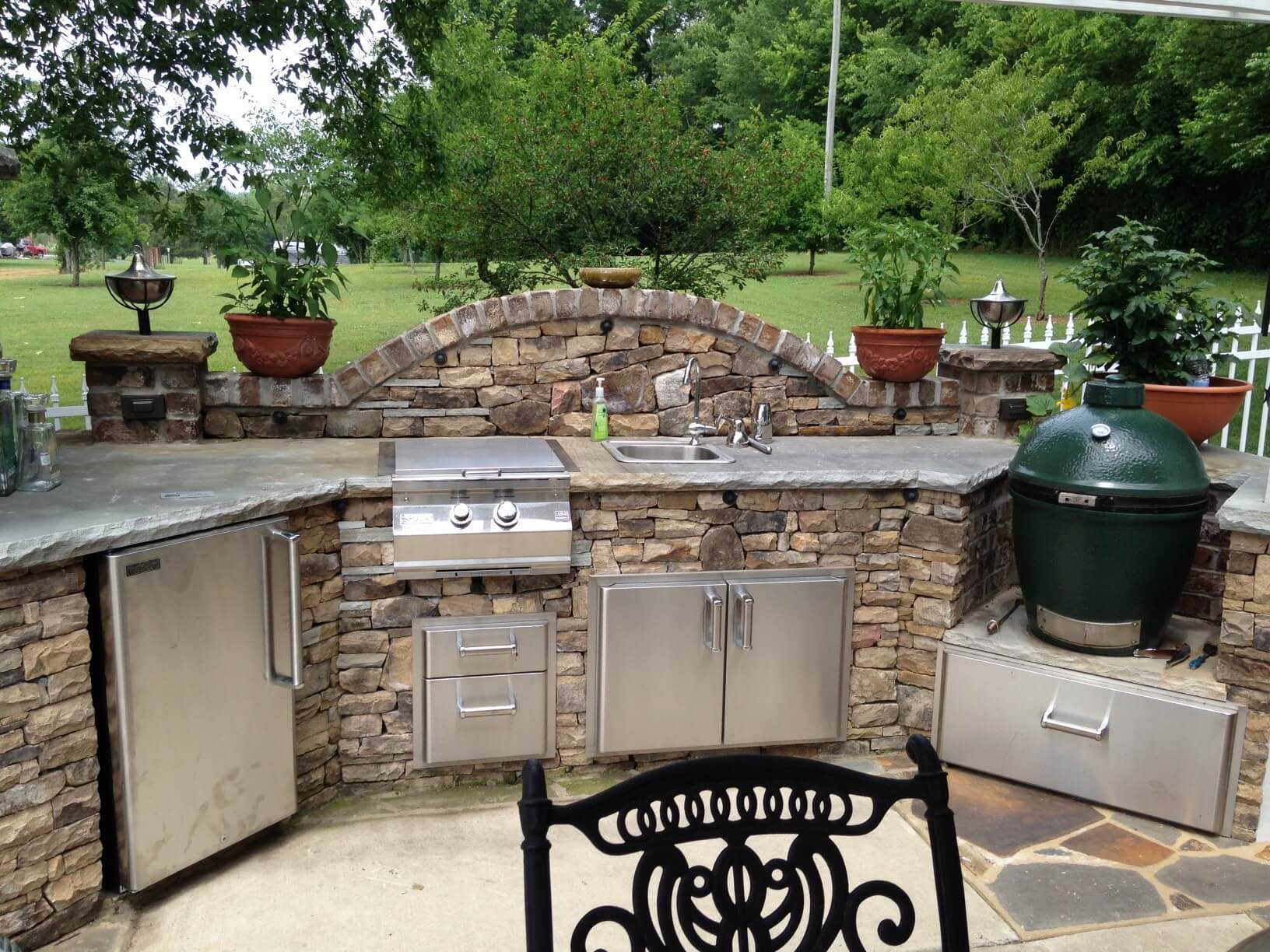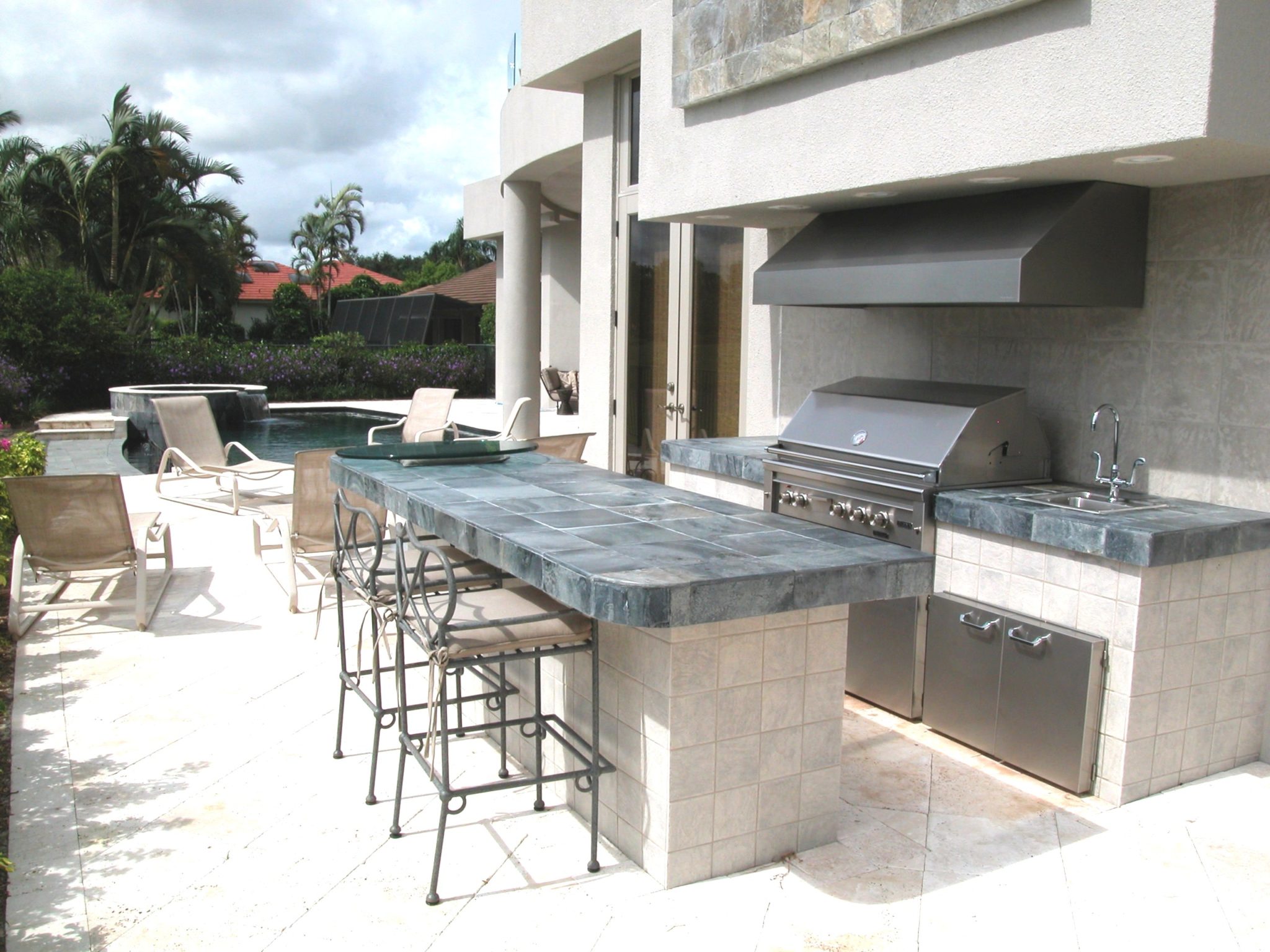Materials and Construction of Outdoor Kitchen Cabinets

The choice of materials and construction techniques significantly impacts the durability, longevity, and overall aesthetic appeal of outdoor kitchen cabinets. Exposure to the elements necessitates the selection of materials resistant to moisture, temperature fluctuations, and UV radiation. Careful consideration of these factors ensures a long-lasting and functional outdoor kitchen.
Material Durability and Longevity, Best outdoor kitchen cabinets
Stainless steel, wood, aluminum, and PVC are common materials for outdoor kitchen cabinets, each offering distinct advantages and disadvantages regarding durability and maintenance. Stainless steel boasts exceptional resistance to rust and corrosion, making it highly durable and requiring minimal maintenance beyond occasional cleaning. However, it can be susceptible to scratching and denting. Wood, while aesthetically pleasing, demands regular sealing and maintenance to protect it from moisture damage and decay. Different wood types exhibit varying degrees of natural resistance; hardwoods generally fare better than softwoods. Aluminum offers a lightweight yet durable option, resistant to corrosion and relatively low maintenance. However, it can dent more easily than stainless steel. PVC, a synthetic material, is highly resistant to moisture, rot, and insects, requiring minimal upkeep. However, it can be less aesthetically versatile than other options and may fade over time with prolonged sun exposure.
Comparative Pricing of Outdoor Kitchen Cabinet Materials
The initial cost and long-term maintenance expenses significantly influence the overall cost of outdoor kitchen cabinets. This table compares the approximate price points of different materials, considering both initial investment and projected maintenance costs over a 10-year period. Note that these figures are estimates and can vary depending on factors such as cabinet size, style, and specific materials used.
| Material | Initial Cost (per linear foot) | Annual Maintenance Cost (per linear foot) | 10-Year Total Cost (per linear foot) |
|---|---|---|---|
| Stainless Steel | $300 – $500 | $10 – $20 | $400 – $700 |
| Wood (High-Grade Hardwood) | $250 – $400 | $50 – $100 | $750 – $1400 |
| Aluminum | $150 – $300 | $10 – $15 | $250 – $450 |
| PVC | $100 – $200 | $5 – $10 | $150 – $300 |
Weather Resistance Construction Techniques
Robust construction techniques are vital for enhancing the weather resistance of outdoor kitchen cabinets. Sealed seams prevent moisture penetration, minimizing the risk of water damage and rot. High-quality caulking and weatherstripping are crucial in achieving this. Protective coatings, such as powder coating for aluminum or marine-grade varnish for wood, provide an additional barrier against UV radiation, moisture, and other environmental factors. Furthermore, the use of marine-grade plywood or other moisture-resistant materials in the cabinet construction significantly improves longevity. Proper ventilation within the cabinets also helps to prevent moisture buildup, reducing the risk of mold and mildew growth. For example, using stainless steel screws and fasteners further enhances resistance to corrosion and moisture damage compared to standard steel fasteners which are prone to rusting.
Styles and Designs of Outdoor Kitchen Cabinets

The aesthetic appeal of an outdoor kitchen is significantly influenced by the style and design of its cabinets. Careful consideration of various design elements allows for the creation of a space that seamlessly blends functionality with the overall outdoor environment. Choices range from classic traditional designs to sleek modern aesthetics and rustic charm, each offering a unique visual impact and enhancing the overall ambiance.
Best outdoor kitchen cabinets – Outdoor kitchen cabinet styles are diverse, reflecting the broad range of architectural and design preferences. The selection of a particular style often dictates the materials used, the color palette, and the overall feel of the outdoor cooking space. Understanding these stylistic nuances is crucial in achieving a cohesive and visually pleasing design.
Popular Outdoor Kitchen Cabinet Styles
Traditional, modern, and rustic styles represent three prominent approaches to outdoor kitchen cabinet design. Traditional styles often feature raised panel doors, ornate detailing, and a rich color palette, evoking a sense of classic elegance. Modern styles, conversely, emphasize clean lines, minimalist designs, and often incorporate sleek, handleless doors, creating a sophisticated and contemporary atmosphere. Rustic styles utilize natural materials such as reclaimed wood, showcasing a weathered, aged appearance that complements natural surroundings. The choice among these styles depends heavily on the overall design theme of the home and the surrounding landscape.
Features Contributing to Aesthetic Appeal
The visual impact of outdoor kitchen cabinets is enhanced by a variety of features. Careful selection of these elements contributes significantly to the overall design’s success.
Several design elements work in concert to create a visually appealing outdoor kitchen. The following points highlight key features impacting the aesthetic outcome.
- Door Styles: Options range from simple slab doors to raised panel, shaker, and recessed panel designs. Each style offers a distinct visual character, impacting the overall feel of the kitchen.
- Handle Designs: Handles can be integrated into the cabinet doors, or discretely placed, providing both functionality and visual appeal. Materials such as brushed nickel, stainless steel, or oil-rubbed bronze contribute to the overall aesthetic.
- Finish Options: Finishes such as painted, stained, or lacquered surfaces impact the durability and visual appearance. Consideration should be given to weather resistance and the desired aesthetic outcome. A painted finish offers a wide range of color choices, while a stained finish highlights the natural wood grain.
Custom-Designed Outdoor Kitchen with Integrated Elements
Imagine an outdoor kitchen with custom-designed cabinets crafted from rich, dark-stained mahogany. The cabinets feature a Shaker-style door design with brushed nickel cup pulls, providing both a classic and modern touch. The cabinets are seamlessly integrated with a granite countertop, its cool grey tones contrasting beautifully with the warmth of the mahogany. Stainless steel appliances, including a built-in grill and refrigerator, are subtly incorporated into the cabinetry, maintaining a clean and uncluttered look. The entire structure is complemented by an overhead pergola, providing shade and enhancing the overall ambiance of the outdoor cooking and dining area. The integrated lighting within the cabinets subtly illuminates the countertops, creating a warm and inviting atmosphere for evening gatherings. The overall design creates a harmonious blend of functionality, elegance, and durability, seamlessly integrating the cabinets with the other outdoor elements to create a truly inviting space.
Functionality and Features of Outdoor Kitchen Cabinets: Best Outdoor Kitchen Cabinets

Outdoor kitchen cabinets are more than just storage; they are integral to the functionality and aesthetic appeal of your outdoor cooking space. Careful consideration of ventilation, storage solutions, and organizational features ensures efficiency and enjoyment. The design choices made directly impact the overall usability and longevity of your outdoor kitchen.
Proper ventilation and storage are paramount in ensuring the longevity and functionality of outdoor kitchen cabinets. Exposure to the elements necessitates robust design considerations to prevent damage and maintain hygiene.
Ventilation in Outdoor Kitchen Cabinets
Effective ventilation is crucial to prevent moisture buildup and the resulting damage to cabinets and stored items. This is especially important in humid climates or areas prone to rain. Features such as louvered doors, strategically placed vents, and open shelving (for less frequently used items) allow for airflow, reducing the risk of mold and mildew growth. Additionally, ensuring sufficient spacing between the cabinets and the wall allows for better air circulation. For example, a gap of at least half an inch between the back of the cabinet and the wall can significantly improve ventilation. Well-ventilated cabinets also help to prevent warping and rotting of the wood, extending the life of your outdoor kitchen.
Storage Solutions in Outdoor Kitchen Cabinets
Smart storage solutions maximize space and improve organization. Deep drawers are ideal for storing larger items like pots, pans, and serving dishes. Pull-out shelves provide easy access to items at the back of the cabinet, eliminating the need for extensive rummaging. Dedicated spice racks keep seasonings organized and readily accessible. Built-in cutting boards and utensil organizers further enhance efficiency. For example, a pull-out drawer with built-in dividers can neatly store utensils, keeping them readily available for cooking. Similarly, a shallow drawer specifically designed for spices maximizes space and keeps spices organized. These features are not just convenient; they contribute to a more efficient and enjoyable cooking experience.
Efficiency and Organization Features in Outdoor Kitchen Cabinets
Several cabinet design elements significantly improve the efficiency and organization of an outdoor kitchen. Pull-out drawers allow for easy access to items stored deep within the cabinets, unlike traditional shelves which often require reaching and rummaging. Spice racks keep seasonings organized and easily visible, preventing the frustration of searching for the right spice. Integrated waste bins discreetly handle trash and recycling, maintaining cleanliness and preventing pests. A dedicated drawer for grilling tools keeps them separate from other kitchenware, improving organization and workflow. The integration of these features contributes to a seamless and user-friendly cooking environment.
Rewritten Article about Outdoor Kitchen Cabinets
Let’s face it, cooking outdoors is amazing! But having a disorganized outdoor kitchen can quickly turn that amazing experience into a frustrating one. That’s where well-designed cabinets come in. Think of them as the unsung heroes of your outdoor cooking space. They’re not just about storing stuff; they’re about making your outdoor kitchen more functional, more efficient, and honestly, a whole lot more enjoyable.
Imagine this: You’re grilling up a storm, and you need that specific spice blend. Instead of hunting through a jumbled mess, you effortlessly pull out a drawer with neatly organized spice racks. Or maybe you need to quickly grab a spatula. A well-designed utensil organizer keeps everything within easy reach. No more fumbling around, no more lost tools—just pure cooking bliss.
That’s the power of thoughtful cabinet design. Features like pull-out shelves, deep drawers, and even built-in trash bins transform your outdoor kitchen from a chaotic space into a well-oiled cooking machine. Consider the materials too; durable cabinets that can withstand the elements will keep your outdoor kitchen looking great for years to come. So, when you’re planning your outdoor kitchen, don’t underestimate the importance of the cabinets. They’re the backbone of your culinary haven.
